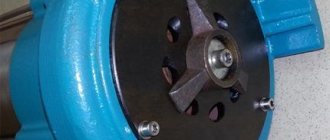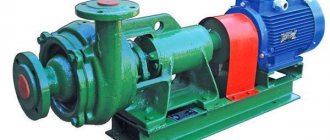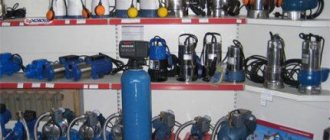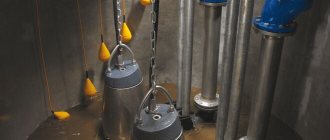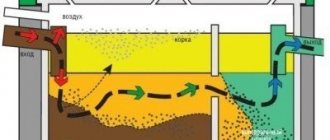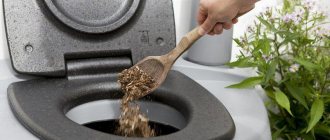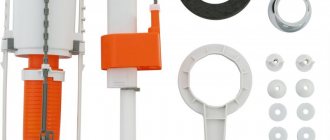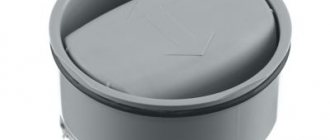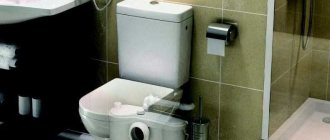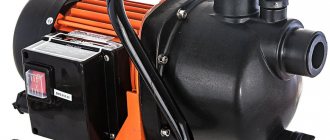When building a country house, it is necessary to create a sewer system. This is necessary to discharge wastewater to a filtration field or to a septic tank. There are various designs in which wastewater moves both by gravity and by forced pumping of liquid. To do this, they use various fecal pumps for sewage – which one to choose is an important question.
Using fecal pumps to pump out sewerage
To pump out wastewater, two types of pumps are used - drainage and fecal. The difference between them is small, but important.
The former are used for pumping dirty liquids containing solid objects no larger than 5 centimeters in size. To protect the working part of the mechanism, a metal mesh is attached to the pump inlet.
Fecal water is noticeably different; it is a thick liquid that often contains fibrous clumps of wool, hair or fabric. They will quickly clog the screen and the pump will stop working. For this reason, a grinder is installed on sewage sewage pumps.
Design and principle of operation of a fecal pump
The main advantage of this small mechanism is the ability to move dense waste through a sewer pipe to a height of up to 7 m and a distance of up to 100 m.
Pump device
These are small but complex devices, the design of which includes:
- Frame. It is made of stainless steel, cast iron or plastic. Considering the operation of the mechanism in an aggressive environment, it is desirable to have a stainless steel case;
- Rotor and stator. Pump motor design elements;
- Shaft. Transmits rotation to the working body;
- Seals. Protects the inside of the mechanism from the ingress of aggressive substances;
- Working turbine. Pumps wastewater from the suction to the supply opening.
The mechanism is equipped with brackets necessary for attaching hoses and cables.
Installation
Before installing the pump in a permanent location, pay attention to the diameter of its inlet pipe. It must match the diameter of the sewer pipe coming out of the toilet. If they do not match, you will not be able to make a tight connection.
A floor sewer pump with a grinder, the installation of which is carried out independently, is mounted in the following sequence:
- supply pipes are inserted into all inlet pipes of the pump (maintaining a slope of 3 centimeters per 1 meter of length) or plugs;
- the pump is installed in a permanent place behind the toilet and attached to the floor using a hammer drill and dowels;
- a sewer pipe is laid from the pump to the drain riser. If several pipes are joined together, the connections between them must be welded, soldered or glued. If it is necessary to vertically remove the pipe from the pump, the pipe should be turned up no further than 30 cm from the pump outlet. In this case, normal pressure will remain in the pipe;
- The drain pipe coming out of the toilet is connected to the pump using a corrugated pipe. In this case, some features are taken into account: the entrance to the pump housing must be located below the level of the pipe exit from the toilet . It is also necessary to tilt the drain pipe to ensure the movement of waste by gravity;
- the toilet grinder pump is connected to the electrical network;
- The operation of the unit is checked and there are no leaks at the joints of the system elements.
Tip: During installation, do not allow the drain pipe to turn at significant angles, as this will place additional stress on the pump components.
We have a separate article on our website about a sewer pump with a grinder for the kitchen. In it you will also find information about popular models and their characteristics.
You can also read what household sewer pumps are and where they are used on our website.
And about the hygienic shower for the toilet there is information on this page https://okanalizacii.ru/santeh_vodoprov/unitaz/gigienicheskij-dush-dlya-unitaza.html. Such equipment brings additional comfort, and its installation is quite simple.
Operating principle and technical characteristics of the pump mechanism
Although this is a complex device, it works simply. When the turbine rotates, it carries wastewater under pressure into the sewer pipe, while simultaneously grinding solid inclusions.
Pumping wastewater under pressure is only necessary if plumbing fixtures are located below ground level (in basements or semi-basements). In this case, wastewater cannot flow from the collector into the septic tank by gravity; it must be pumped forcibly.
The daily volume of fecal water and the technical characteristics of the pump are important here:
- Productivity - the amount of waste that the mechanism is capable of pumping in 1 hour (for example, 100-200 l/hour);
- Power consumption - for use in a country house, a low-power pump is enough - no more than 400 W/hour;
- The height of the column (the pump is not at all below the soil level) or the immersion depth of the mechanism - for fecal pumps 15 m maximum;
- Mains voltage – in a private house, it is better to install pumps with an operating voltage of 220 V.
The characteristics of the equipment used for pumping fecal water are varied, but in each case it is possible to select the optimal parameters of the device.
Conclusions and useful video on the topic
Overview of the technical characteristics of the pump from the Polish manufacturer:
Fecal pumps containing a grinder in their designs should be considered technical equipment designed to serve not only for the benefit of industrial production farms. This equipment is necessary for any private household, as it has wide functionality for pumping out contaminated liquids.
You can talk about how you selected and used a fecal pump in the block below. Please write comments, ask questions about controversial and unclear points, photo dividers and useful information on the topic of the article.
Sewage pumps types/types/varieties
Although there are many different models of such pumps, they are all divided into several types:
Submersible mechanisms are made of durable materials; they always have a float mechanism for turning the device on/off. The pump has a sealed housing; all connections are equipped with gaskets that protect the inside of the device from exposure to aggressive environments. They are mainly used for emptying cesspools, but they are also suitable for pumping out storm drains. They are capable of solving many problems; a submersible fecal pump can even be used to drain a vegetable garden. They are installed at the bottom of the tank, secured to the suction pipe. The float switch is able to turn off the device in time, preventing it from being turned on after the container is empty (because of this, the pump may burn out). The pumped fecal water serves to cool the mechanism. A submersible pump is a very reliable device;
Semi-submersible mechanisms have a smaller outlet pipe diameter. It is capable of pumping wastewater with solid inclusions of maximum 15 mm. But they must be equipped with a device for grinding solids, for this reason they can be used for pumping out wastewater. Semi-submersible mechanisms are mainly installed on a floating platform, which is always at the same level with the pumped liquid. When this device operates, the bottom of the pump is always immersed in liquid, and the top part is in the air;
Surface pumps are placed outside the tank with fecal waste, for this reason they require a protective casing. These mechanisms are low-performance; they can pump wastewater with solid inclusions up to 5 mm in diameter. But the long service life and low cost of the device make it attractive to owners of private houses;
Domestic sewer stations are used for pumping waste fecal water; they allow solving several problems:
- Possibility of pumping out fecal water, along with water coming from other plumbing fixtures installed below the level of the sewer line. Such pumps make it possible to raise wastewater to a height of up to 15 m, thanks to this it is possible to install household plumbing in the basement or basement;
- The use of these devices makes it possible to transport wastewater and fecal matter over a distance of up to 100 m, without thinking about providing the necessary slope. There is no problem with seasonal soil movements, which can deform a long sewer pipe;
- The use of a grinder for large inclusions allows you to obtain a homogeneous mass of fecal waste, which allows you to lay a sewer pipe with a diameter of 40-50 mm;
- These pumps allow you to install a carbon filter, which will prevent unpleasant odors from entering the room.
To select a suitable pump, take into account:
- At what depth is the sewer system laid and are there any differences in the height of the laid pipe;
- Type of wastewater – composition of inclusions and temperature;
- The amount of wastewater that needs to be pumped;
- The need for automatic operation and a suitable way to control the pump.
Household sewage pumping units are small in size and do not require much space.
Feces grinders
First of all, you need to find out what materials need to be crushed:
- From the kitchen sink, where, in addition to fats, food debris gets into the sewer system, leading to clogged pipes;
- The washing machine and sink produce animal hair, hair and fibrous materials when washing fabrics. Combining with fats, they form dense blockages;
- Tampons, all kinds of napkins and paper end up in the sewer system.
All this waste must be processed by a shredder. This device works like a simple meat grinder. The device itself acts as an auger that moves the crushed material. Taking into account the characteristics of the waste being processed, the grids and knives of the mechanism are made from high-strength stainless and alloy steels.
Knives of several shapes are used:
- impellers with blades-knives;
- knife-like meat grinders;
- cylindrical scissors;
- cross secateurs;
- knives in the form of plates.
It is important that no stones or similar objects get into the shredder, otherwise the mechanism may break.
Selecting a fecal pump
To pump out sewerage, you need to choose a device taking into account several characteristics:
- Supply voltage, which affects the energy costs required for pumping wastewater. Usually in your own home you use a voltage of 220 volts, but you can also buy pumps designed for 380 volts;
- Power consumption for such a device, this characteristic should not be less than 400 watts. This directly affects the pressure of the pumped waste, which is necessary to overcome the resistance of the pipeline contents;
- For submersible pumps, the possible immersion depth of the device must be taken into account. And for external ones - the permissible length of the intake sleeve;
- The performance of the mechanism is important - the volume that can be pumped in a certain time. It should not be less than the calculated indicators of incoming wastewater. In most cases, 400 watts of pump power is enough to pump out 80-100 liters of wastewater per minute;
- Be sure to equip the device for removing waste with automatic on/off devices. Protection against engine overheating, short circuit, and electrical breakdown is required. It is necessary to provide for the installation of check valves that make the reverse flow of wastewater impossible.
It is important to consider the reputation of the equipment manufacturer. Now on the market you can find many fakes that copy equipment from reputable and well-known manufacturers. For this reason, it is necessary to study the source of origin of the pump and all quality certificates for the product.
Areas of application
If it is impossible to organize the natural discharge of sewer water, fecal matter, the contents of storm sewers and septic tanks into a centralized sewerage system or to a safe discharge point, fecal pumps are used for further storage and processing. Their task is to ensure the transportation of contaminated water from the point of formation and initial accumulation to a safe, permitted discharge. Such situations can be characterized by two simple circumstances:
- The point of initial accumulation of wastewater is located below the level of the main sewer system.
- The discharge point is located remotely and there is no possibility of organizing a pipeline for natural discharge.
In the first case, the matter concerns all premises with equipped bathrooms, showers, sinks and other sources of liquid waste, located in basements, cellars and, in principle, below the level of the sewer system. Surface-mounted pumps allow you to solve the task more accurately. They require less space to work, and they allow you to get by with a small-capacity tank for preliminary collection of wastewater.
Sewage water collection tank
The second circumstance affects all private plots, country houses and dachas, buildings and objects remote from the city infrastructure that simply do not have the opportunity to connect to a centralized sewerage system. In this case, the fecal pump is used to transport fecal and drainage water to remote discharge points or periodically empty storage tanks for removal.
Rules for using equipment
Every technically complex mechanism can quickly break down if used incorrectly. For example, the operation of a submersible pump after pumping liquid from a container. This type of pump uses pumped wastewater for cooling. If the drains run out and the pump continues to work, the engine will quickly burn out from overheating.
The same thing will happen if you use the equipment for other purposes. For example, it is dangerous to pump out drainage water with it. The reason is that there are a lot of hard stones in the pumped liquid. In the shredder, these particles will damage the knives, and the pump will no longer be able to work normally.
Before putting the fecal pump into operation, you must familiarize yourself with the operating rules. Violation of them may result in early termination of the equipment warranty.
Correct operation
Any technically complex product can quickly fail if the rules for its use are violated. An example is the operation of a submersible pump in air.
For such a unit, the pumped liquid is cooling. If the heat exchange is insufficient due to the partial openness of the housing, the pump motor will very quickly fail.
Sturm WP9709SW - inexpensive fecal pump for a summer residence with a chopper knife
The same result awaits a device used for other purposes. It is dangerous to use such a pump as a drainage pump. Because the pumped dirty liquid often contains solid inclusions in the form of pebbles. When it enters the shredder, it immediately disables its blades, which leads to its breakdown.
Before you start using the fecal pump, you must carefully read the rules for its use. Violation of them may result in refusal of warranty repair of the device or its replacement.
Main manufacturers of fecal pumps
This equipment is produced by many manufacturers. Common in our market:
Pedrollo pumps. Mechanisms of this brand are used for pumping very dirty wastewater. The most common are the VXm MC/MCm lines. Of these, the first ones are not very powerful; their operation requires power from a 220 volt network, the rated power of the pumps is 0.6 kW. These are the most common devices for pumping out fecal water in private homes. According to the instructions, it is allowed to pump wastewater with a solid element size of up to 35 mm. Technical characteristics of the equipment:
- voltage 220-380 volts;
- maximum liquid level to the bottom of the container – 40 mm;
- device productivity 15-66 l/hour;
- Pumps of this brand can be immersed to a depth of 8-22 m;
- the diameter of the outlet pipe is 1.5-2.5 inches.
Fecal pump Grundfos SEG. The unit is equipped with a grinder and is designed for pumping sewage, drainage water, and wastewater. It is capable of pumping wastewater over considerable distances, but the pipe size is limited to 40 mm.
Main characteristics of the equipment:
- body material – cast iron;
- the pump is equipped with an impeller adjustment system;
- 2 relays are installed to protect the device from overheating;
- used for pumping to a depth of 10 meters;
- the maximum permissible temperature of the pumped liquid is 40 degrees.
Sewage pumps Gillex. The company produces two types of pumps – Fekalnik and Drainazhnik, the names of which indicate their purpose. The permissible size of solid inclusions is 35 mm.
Main technical characteristics:
- productivity 160-260 liters per hour;
- immersion depth – 6-11 m;
- installation of a float switch.
Sulzer – pumps for pressure sewerage. This is a station for pumping fecal wastewater with its simultaneous processing into a liquid mass. Their advantage is that they are quick to install and get up and running. The station is equipped with a reliable check valve and a powerful solids grinder.
The Vortex fecal pump is designed for pumping wastewater with strong fibrous contaminants. Used for domestic purposes. Main technical characteristics:
- power 450-1500 watts;
- pressure 9-18 meters;
- productivity 16-24 cubic meters per hour;
- solid inclusions of 15-42 millimeters are allowed;
- permissible liquid temperature is 40 degrees.
Using a pump for forced pumping of sewage is often a forced decision that is influenced by the surrounding landscape.
Characteristics
As already mentioned, the concept of surface sewage pump covers a huge number of solutions with different characteristics and types of execution, especially when it comes to sewage pumps for indoor installation.
For pumps designed for pumping wastewater from septic tanks, cesspools, etc., the main characteristics are:
- Productivity, m3/hour (liter/min);
- Head, m;
- Fluid temperature;
- Engine power;
- Installation method (horizontal/vertical);
- Acceptable particle size.
The pressure is indicated in meters and determines the height to which the pump is capable of lifting liquid. To understand what value is needed to select a specific model, you should add the height from the bottom of the tank to the pump and from the pump to the discharge point. A tenth of the length of the horizontal section of the pipeline is also added to this value, which also creates resistance to fluid flow and is approximately 10 times less than the vertical rise.
Fecal pumps are divided into two types:
- For working with cold wastewater up to +40°C.
- For working with hot wastewater up to +90°C.
If you need to equip a bathroom with a shower, a dishwasher, or a washing machine with a fecal pump, then a unit for hot waste must be installed.
To estimate the required performance, you should calculate the approximate water flow and select the largest value. You can navigate using the following table:
| Consumer | Flow l/min | Consumption m³/hour |
| Washbasin with sink | 10 | 0,6 |
| Washbasin | 10 | 0,6 |
| Bath/hydromassage | 18 | 1,08 |
| Shower | 12 | 0,72 |
| Toilet | 7 | 0,42 |
| Bidet | 6 | 0,36 |
| Washing machine | 12 | 0,72 |
| Kitchen sink | 12 | 0,72 |
| Dishwasher | 8 | 0,48 |
| Water tap 1/2″ | 20 | 1,2 |
| Water tap 3/4″ | 25 | 1,5 |
| Total: | 140 | 8,4 |
In this case, you should choose a pump with a capacity of 10 m3/hour.
Installation of a fecal pump
Installing a fecal pump is not a difficult, but responsible job; you can do it yourself. In difficult cases, if there is no necessary experience, it is better to invite specialists.
Pump installation
Before installing the equipment, it is necessary to prepare the installation site and connect the electrical panel. Sometimes it is necessary to additionally install a fecal pump in a separate room - in the kitchen or bathroom, and so on. The most important thing in this case is not to connect the devices to one electrical panel; for each of them you need to provide its own connection and its own input into the sewer system.
Important! Take the wastewater temperature into account. A dishwasher or washing machine in the kitchen requires the use of a pump that is designed to pump hot liquid.
When installing a fecal pump, you need to follow a few simple rules:
- connect the mechanism to a separate electrical panel;
- secure the mechanism well;
- an external fecal pump is mounted on the edge of a container with waste water;
- the submersible pump must be lowered directly to the bottom;
- semi-submersible pump - install so that the upper part is at the top and the working mechanism is lowered into the liquid.
Installing the device in a toilet is characterized by the use of a larger diameter sewer pipe, and it is necessary to install a pump with a grinder - it is necessary to grind toilet paper and feces. The mechanism should be located no further than 40 cm from the toilet.
After the pump is finally installed and connected to the electrical network, it is necessary to test the equipment and adjust the operation of the float switch according to the liquid level. Ev container is filled with water to the minimum level, this will be the shutdown point. After this, water is poured in until the pump switch is activated. If you notice noises or malfunctions in the operation of the equipment, it is advisable to eliminate them immediately. If there are no comments, you need to seal the well.
Sewage grinders
In the case of processing household wastewater, you first need to figure out what materials need to be crushed:
- In addition to grease, kitchen sinks can also release food debris into the drain and cause a clog unless it is mixed with other fibrous materials from other sources.
- The most annoying items in sinks and washing machine drains are fibrous materials, hair, and animal dander. Combining with fats from the kitchen sink, they can create dense clogs.
- The toilet sewer pump removes the most significant clogging items, such as paper, various napkins and tampons.
The shredder has to deal with all these waste-contaminating materials.
Essentially, this design element works like an ordinary meat grinder. In this case, the role of the auger for moving the crushed mass is performed by the device itself, creating a retracting force.
Taking into account the characteristics of the processed material, high-strength materials made of alloyed stainless steel are used for the manufacture of knives and grilles.
Knives of the following shapes are practiced for installation:
- in the form of impellers with knives - blades;
- cutter based on the principle of a meat grinder;
- cylindrical scissors-knives;
- cross secateurs;
- lamellar cutters.
How to choose a fecal pump for sewage
If you need equipment for pumping out wastewater, it is important to pay attention to several characteristics of the device when purchasing.
The mechanism will work for a long time if you take into account:
- required performance;
- sewer pipe diameter;
- total amount of wastewater;
- pump immersion depth;
- pressure;
- type of mechanism;
- pump power;
- additional options – chopper, liquid volume control;
- the manufacturer of the product.
Maximum head
This characteristic indicates the pressure that the pump can create. This is the second most important indicator of the effectiveness of the mechanism. It is measured in meters, as this allows you to understand to what height the pump is capable of pumping liquid. It is necessary to choose a pump so that its pressure is sufficient to lift the liquid to the required height. Greater pressure can only be achieved by using expensive, high-performance devices.
Suction/immersion depth
It is necessary to take into account the characteristic of the device, which depends on the location of the personal plot - the immersion depth. This indicator is determined by the purpose of the mechanism, and affects the ability to pump wastewater; it happens within 3-20 m.
Power
When choosing a suitable pump for pumping sewage, consider its power. This directly affects the performance of the equipment, the ability to pump out viscous substances containing solid particles and the energy costs during operation. This characteristic affects the pressure; the power depends on the manufacturer and model.
Working temperature
Any fecal pumps intended for domestic sewage are divided into 2 types:
- For cold wastewater - the liquid temperature does not exceed 45 degrees;
- For hot wastewater – liquid temperature up to 90 degrees.
When only cooled liquid enters the sewer, it is better to use models designed for cold water, but it is not prohibited to install pumps for hot water (but they are more expensive). These pumps are used in private homes. Hot water enters the sewer system from the washing machine and dishwasher and during emergency discharges of coolant from the heating system.
Automatic control
To control the pump when pumping out wastewater manually, you will have to turn it on and off yourself all the time, and this is inconvenient. Will be required to be near equipment frequently. It is better to purchase devices that include:
- A float is an element that determines the height of wastewater in a tank; it allows you to turn the equipment on and off in a timely manner;
- Thermal relay is a device that is triggered when the electric motor is significantly heated, this allows you to turn off the power to the pump in a timely manner, preventing overheating.
To reduce the risk of clogging of the pump with a grinder, manufacturers sometimes install a self-cleaning device for the mechanism that crushes large particles. This makes it possible to increase the service life of equipment without stops and interruptions in operation. Cleaning the chopper yourself further reduces the risk of motor overheating.
The most efficient and most reliable fecal pumps are devices with a metal body and working part. For this purpose, stainless steel and cast iron are used. Plastic products cost less, but when working in an aggressive environment they will fail faster.
Choosing a pump for a private home
When choosing such an installation for the sewage system of a private house, you should take into account the parameters of the system itself, namely:
- Supply voltage, and, consequently, energy consumption for pumping fecal waste. For a private home, a voltage of 220 volts is usually sufficient, but units designed for 380 are also available for sale.
- The power consumption parameter is important. Taking into account real loads, equipment less than 400 watts for fecal pumps is practically not produced. However, if we are talking about the sewage system of a private house, this power is quite enough.
- Such a parameter as the pressure it creates directly depends on the power of the pump. This characteristic is expressed in meters of water column, but it does not show the lifting height itself, but also the force required to overcome the resistance of a horizontal pipeline. The pressure when pumping thick fecal wastewater has a slightly different meaning, so manufacturers of fecal pumps provide real indicators in the form of a table in the accompanying technical documentation.
- For submersible pumps, the parameter of the permissible depth of their immersion is important. And for outdoor installations - the depth of the intake hose.
- What matters is the performance indicator of the unit - the volume of product that can be pumped per unit of time. It should be consistent with the calculated fluid flow rates. For domestic sewerage, a power of 400 watts is enough to pump up to 100 liters per minute, which is quite enough for its intended use.
- The sewage sewage pump must be equipped with a float-type on/off automatic switch. In addition, protection against overheating, breakdown, short circuit and other parameters is needed. The unit must be protected with check valves to prevent the reverse flow of liquid.
- The reputation of the equipment manufacturer is important. Currently, there are many people who want to make counterfeits of a well-known and reputable brand. Therefore, when making a decision regarding the purchase of a certain model, you need to carefully study the certificates of quality and origin of the product.
How much does a sewer pump cost in a private house?
The variety of device models on the construction goods market is amazing. Literally hundreds of types and designs of fecal pumps indicate the popularity of suburban housing in a comfortable design.
Along with products from well-known European manufacturers, Russian-made units are presented on the market en masse. You can purchase them at a very affordable price from 3,000 rubles.
At the same time, there are products at extremely high prices, reaching the level of 132 thousand.
Based on price indicators, pumps can be divided into three categories:
- budget, costing from 3 to 20 thousand;
- mid-price products – from 20 to 50;
- expensive units - from 50 and above.
It is noteworthy that branded products are present in all price categories of fecal pumps. This should alert the buyer, since belonging to a well-known manufacturer itself costs money. Sales at prices close to bargain prices indicate some dishonesty of the seller.
Choosing a unit that is suitable in terms of technical parameters is not difficult - the range of products is very wide. But as for performance indicators, it is advisable to prefer products from domestic manufacturers.
In this case, the main criterion is its maintainability. You can always find the right part on the market, and any more or less trained person can replace a broken one.
